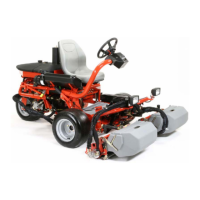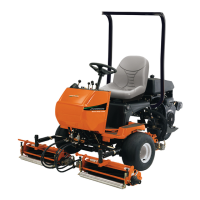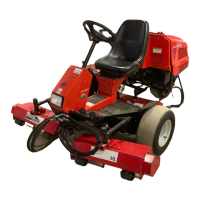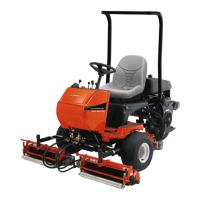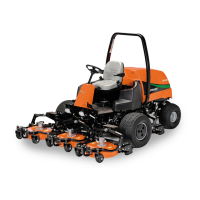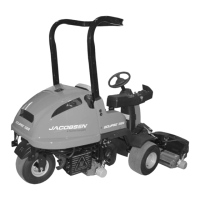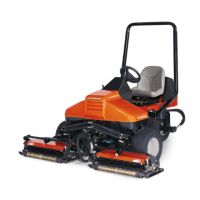B
en 47
OPERATION 6
6.18 MOWING ON SLOPES __________________________________________________
The mower has been designed for good traction and
stability under normal mowing conditions. Use caution
when operating on slopes, especially when the grass is
wet. Wet grass reduces traction and steering control.
1. Always mow with the engine at full throttle, control
forward speed using traction foot pedal to maintain
proper cutting.
2. Use weight transfer control as required to improve
weight distribution between decks and mower.
3. If the mower tends to slide or the tyres begin to mark
the turf, angle mower into a less steep slope until
traction is regained or tyre marking stops.
4. If mower continues to slide or mark the turf, the slope
is too steep for safe operation. Do not make another
attempt to climb, and back down slowly.
5. When descending a steep slope, always lower
implements to the ground to reduce the risk of
mower overturning.
Correct tyre pressure is essential for maximum
traction. See 3.2 Specification.
WARNING
To minimize the possibility of overturning, the
safest method for operating on hills and
terraces is to travel up and down the face of
the slope (vertically), not across the face
(horizontally). Avoid unnecessary turns, travel
at reduced speeds, and stay alert for hidden
hazards. To ensure best stability always load
the left hand storage rack first and cut with all
three units powered.
WARNING
DO NOT USE ON SLOPES GREATER
THAN 16°
!
!
XX° Maximum
A = Maximum Allowable Slope
A = Maximum Allowable Slope
0°
0%
2-3/4°
5%
5-3/4°
10%
8-1/2°
15%
11-1/4°
20%
14°
25%
16-3/4°
30%
19-1/4°
35%
21-3/4°
40%
24-1/4°
45%
26-1/2°
50%
28-3/4°
55%
31°
60%
33°
65%
35°
70%
36-3/4°
75%
38-3/4°
80%
40-1/4°
85%
42°
90%
43-1/2°
95%
45°
100%
Degrees
Grade
General slope of roadway embankment - 45°
Steepest grass area - 31°
Slope of average roof - 19.25°
2nd class highway maximum grade 4.5°
Toll road or freeway - 1.75°
Degrees are shown to the nearest 1/4”.
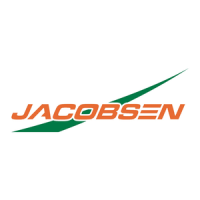
